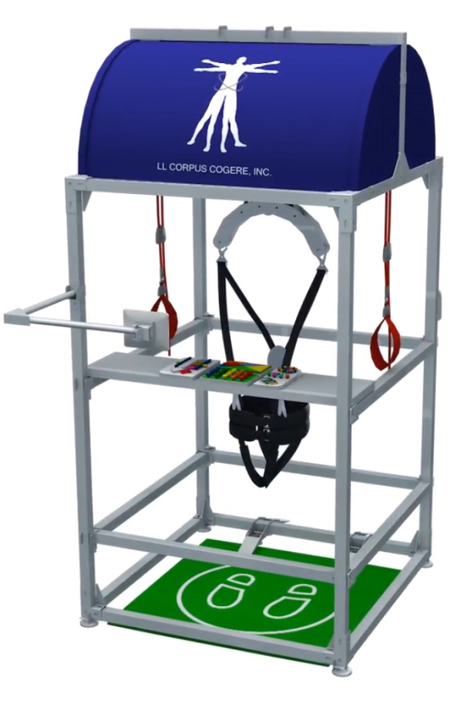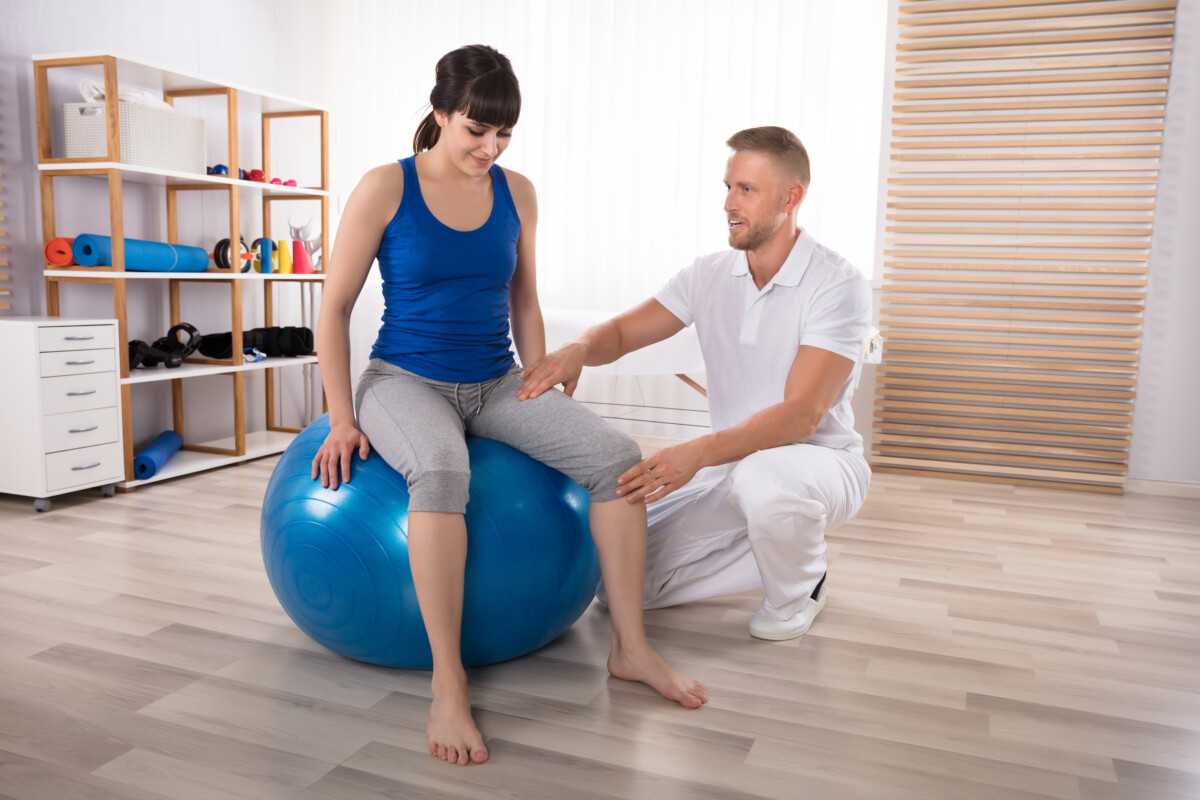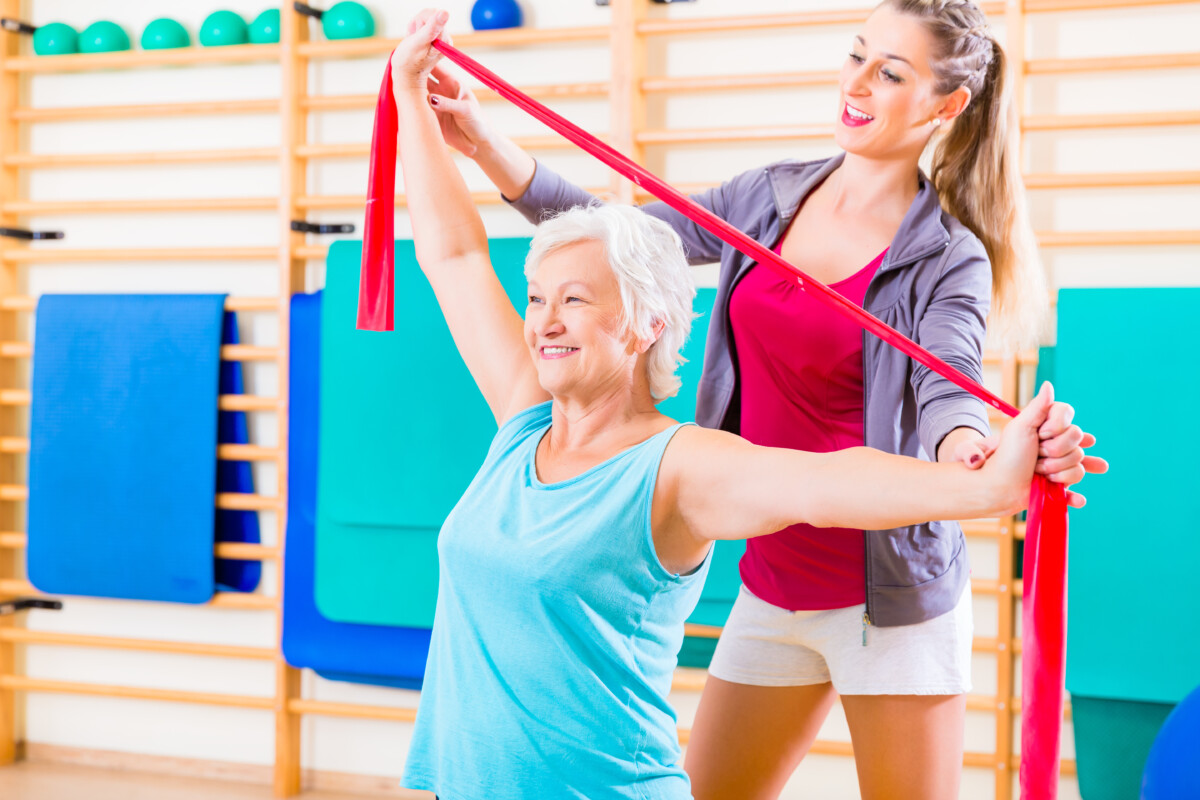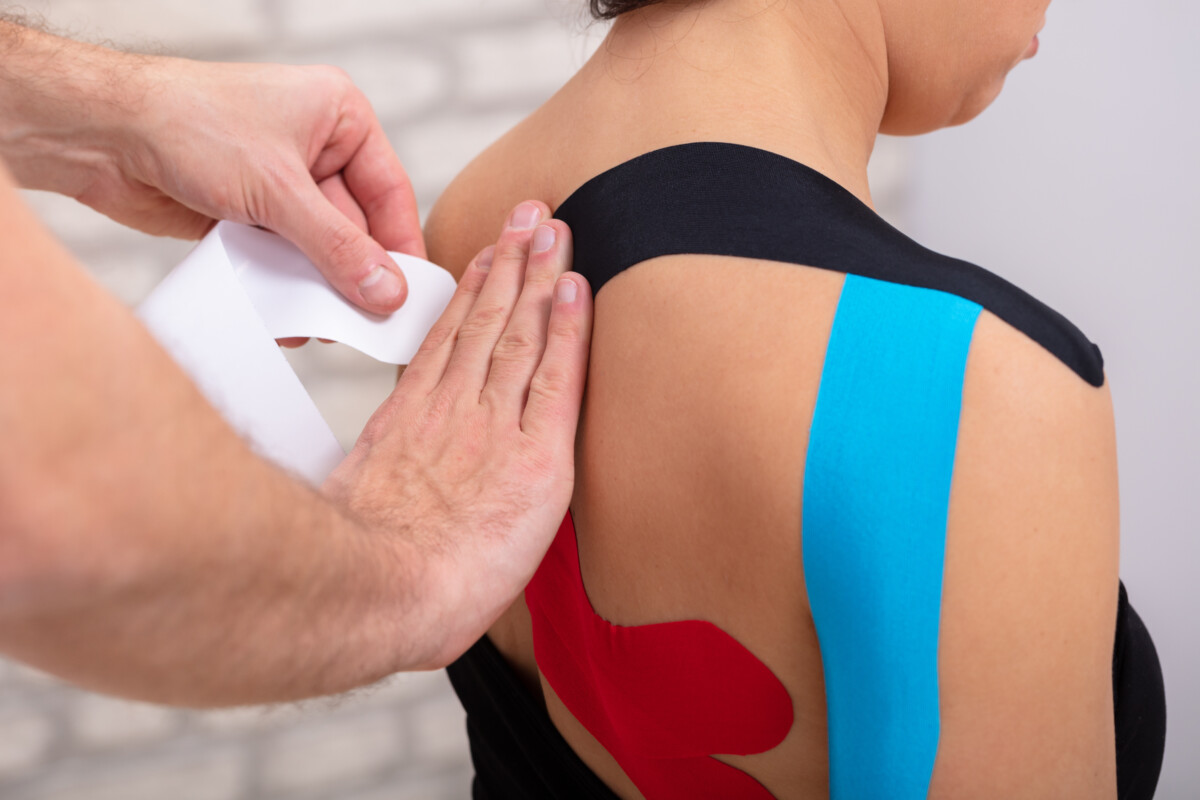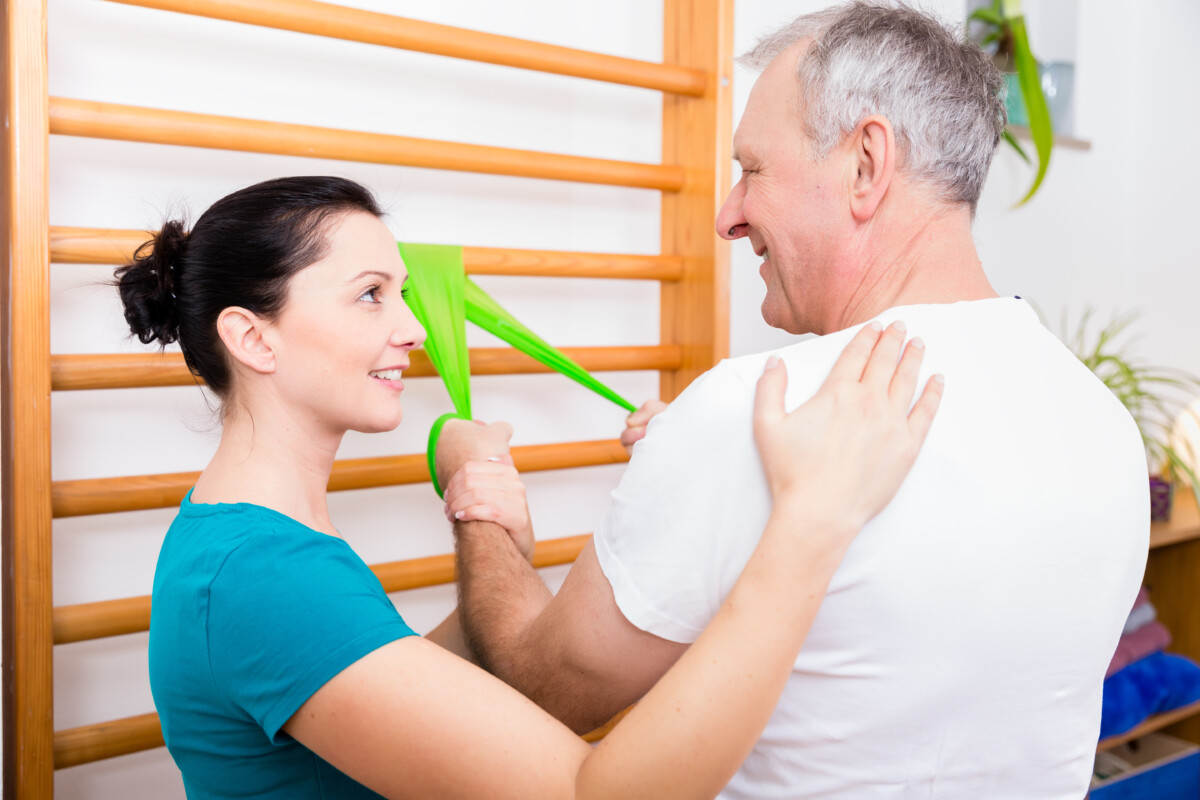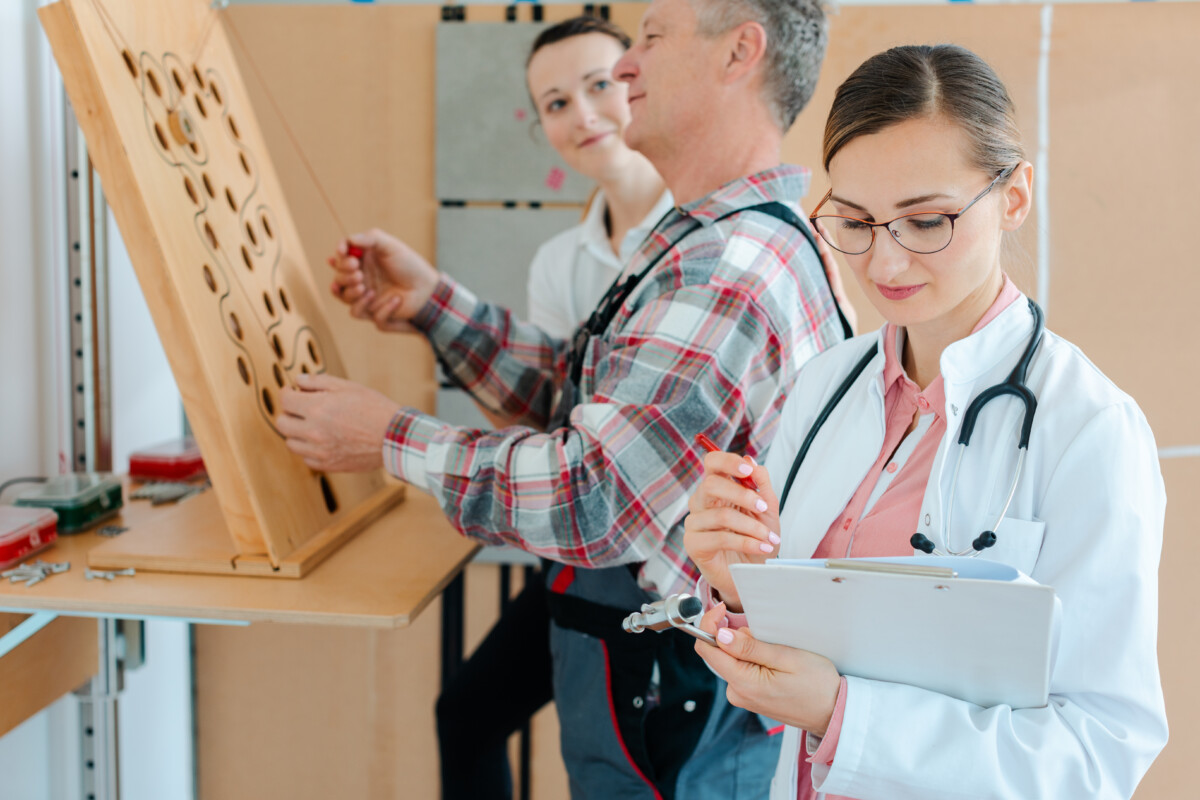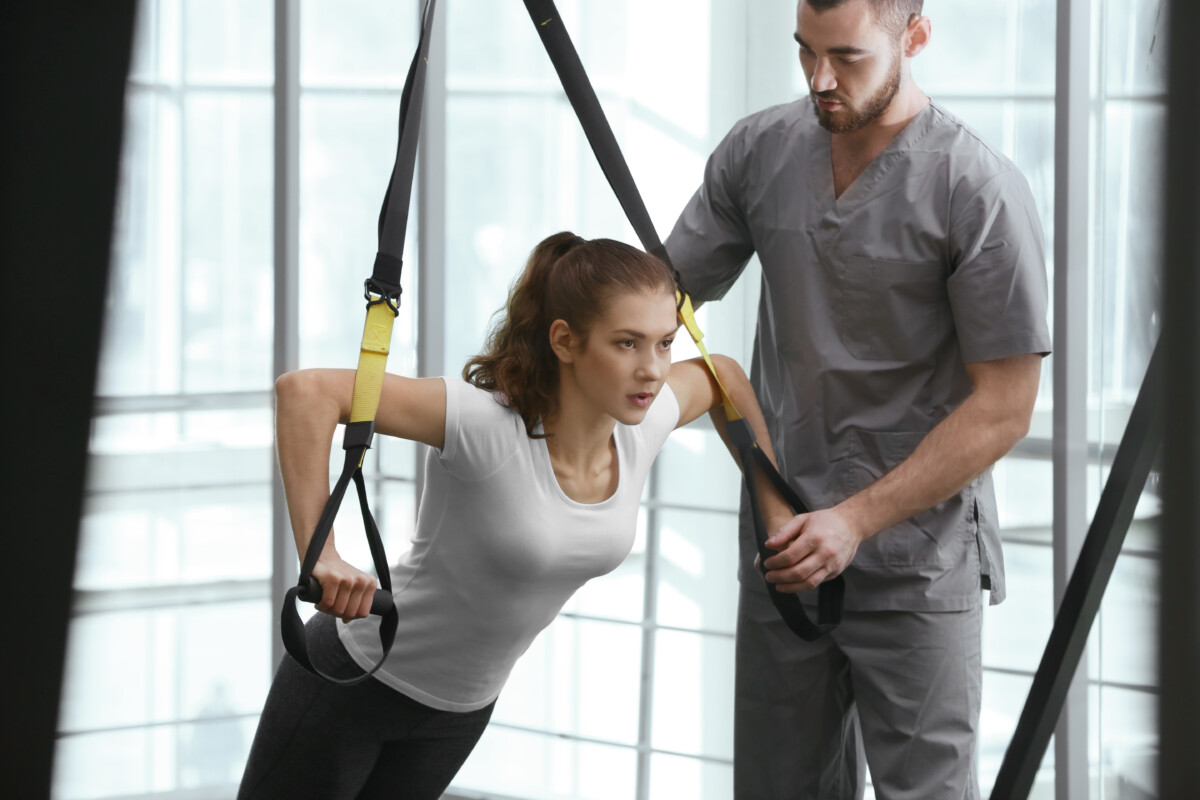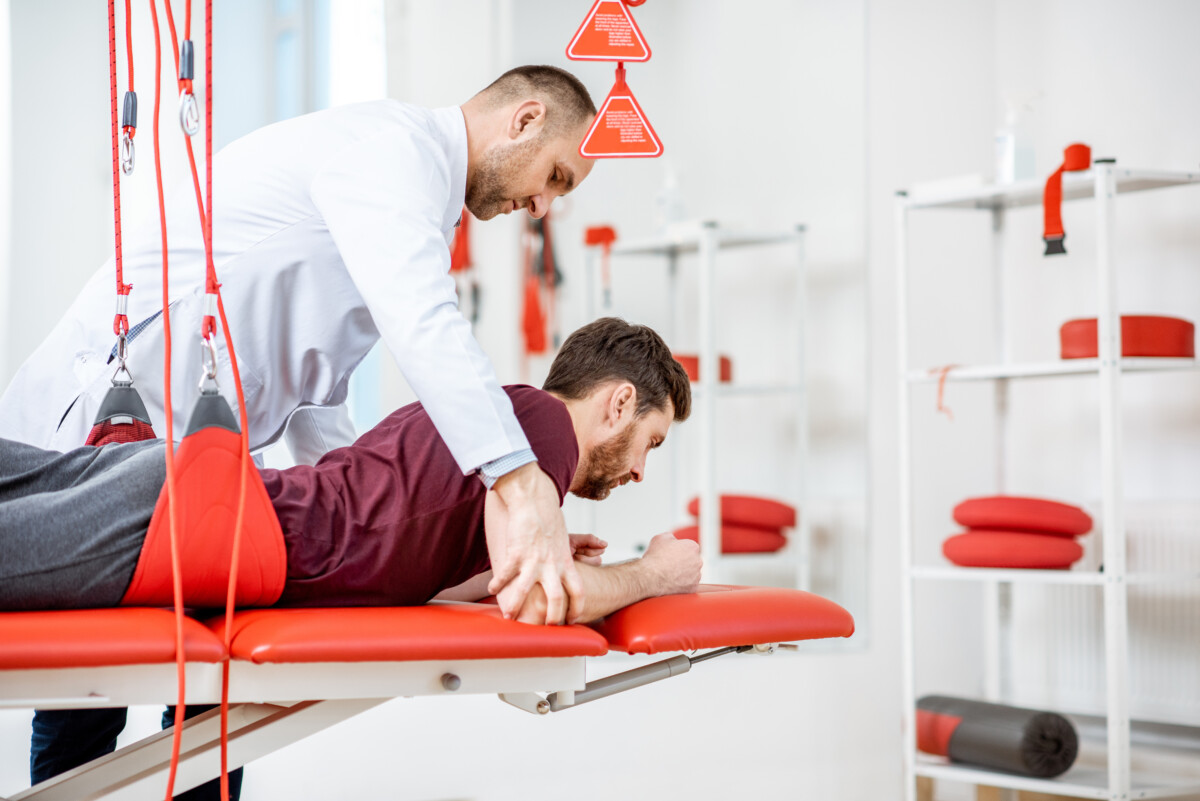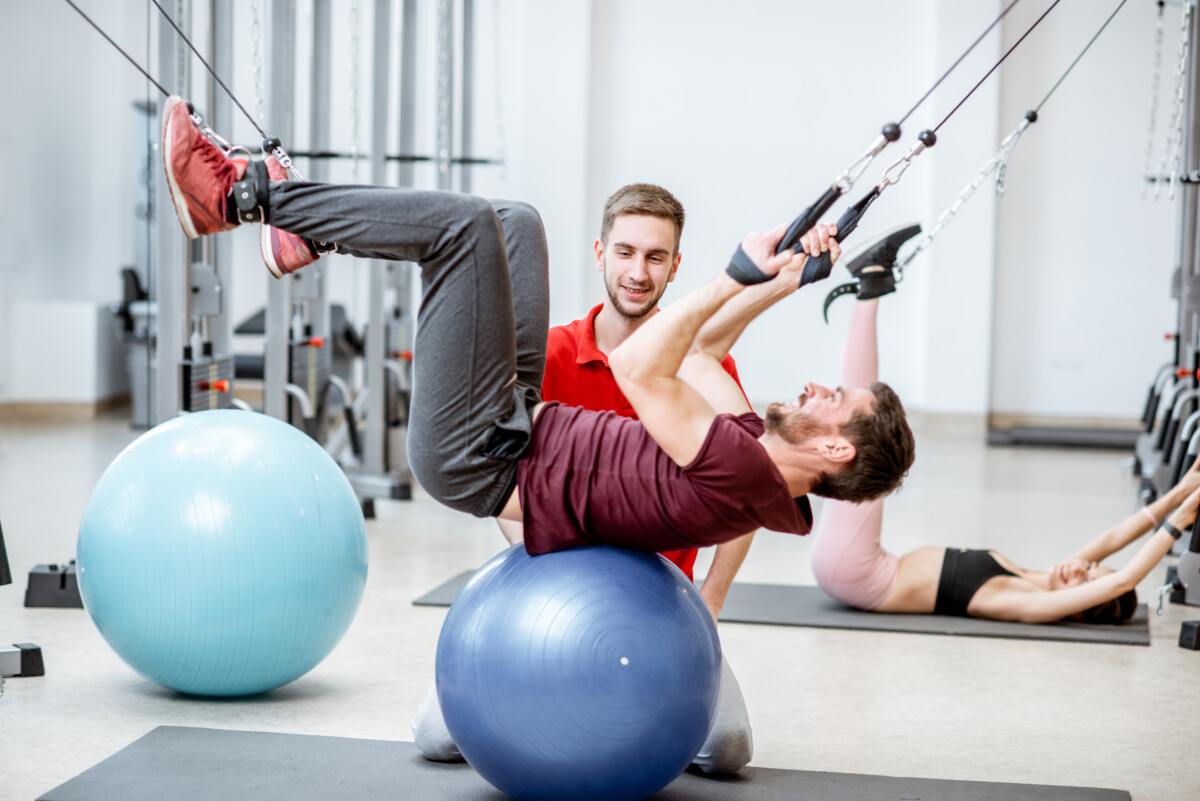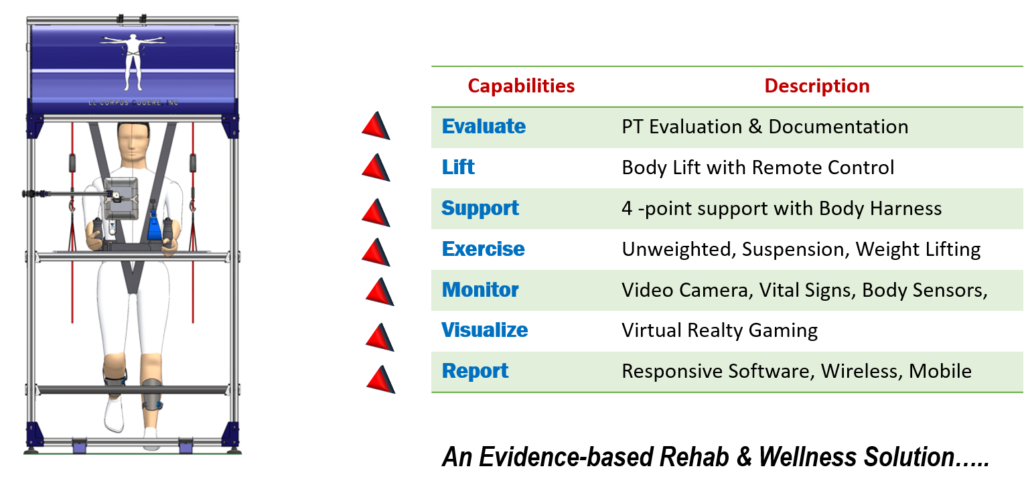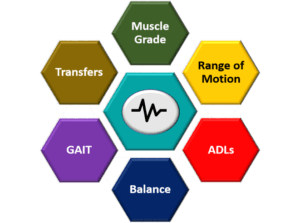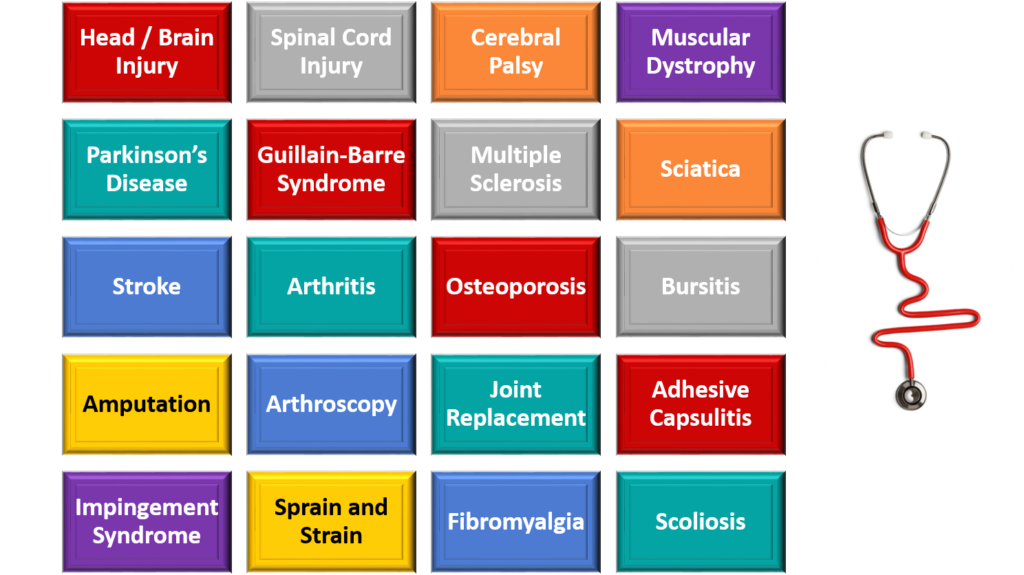A. MINI CLINIC Description and Use
The MINI CLINIC is a small foot-print IoT-based integrated rehabilitation and wellness equipment and software solution for use by ambulatory and non-ambulatory patients, recovering from neurologic and orthopedic conditions and improving quality-of-life for wellness patients.
The MINI CLINIC safely lifts and secures patients, within a body harness, and provides physical and occupational therapy mechanisms, for conducting effective rehabilitation and wellness programs, within one piece of equipment and supports:
- Positive patient recovery after an injury or a surgical repair, to move from non-weight bearing, to partial to full weight-bearing status.
- Quality of Life improvement for wheelchair-bound ambulatory patients to conduct upper and lower body exercises.
The MINI CLINIC includes the components and accessories shown below with their product release version.
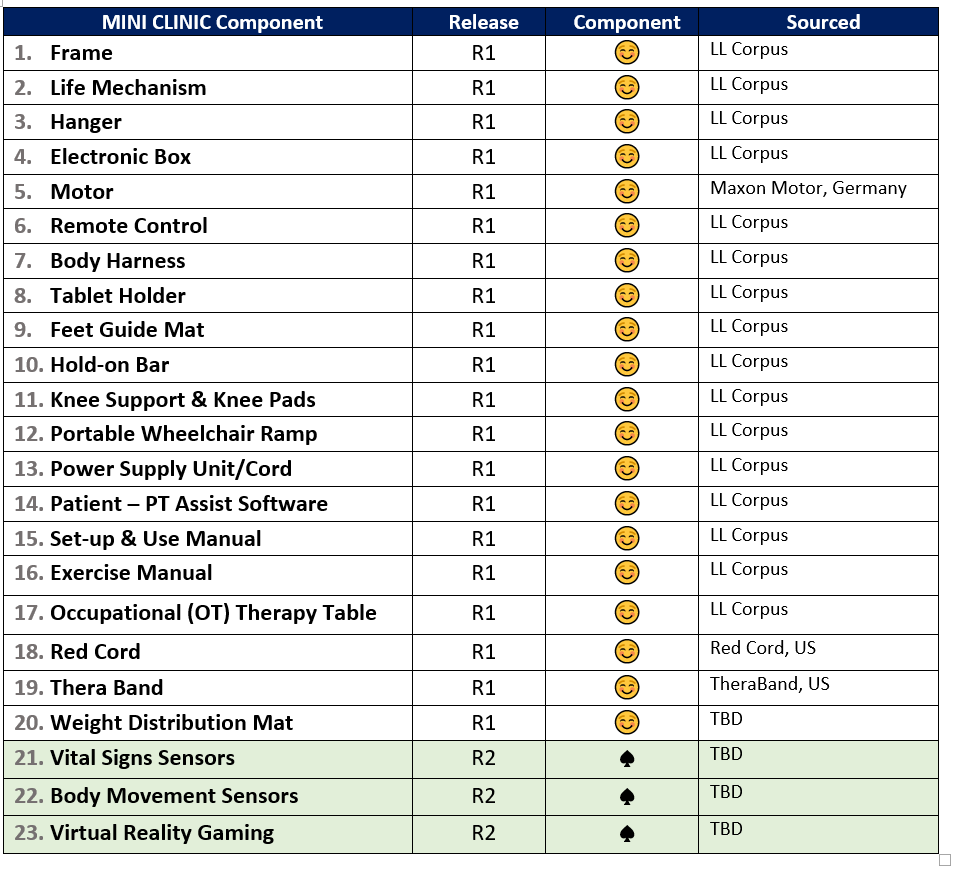
MINI CLINIC ™ supports the neurological and orthopedic medical conditions outlined below.
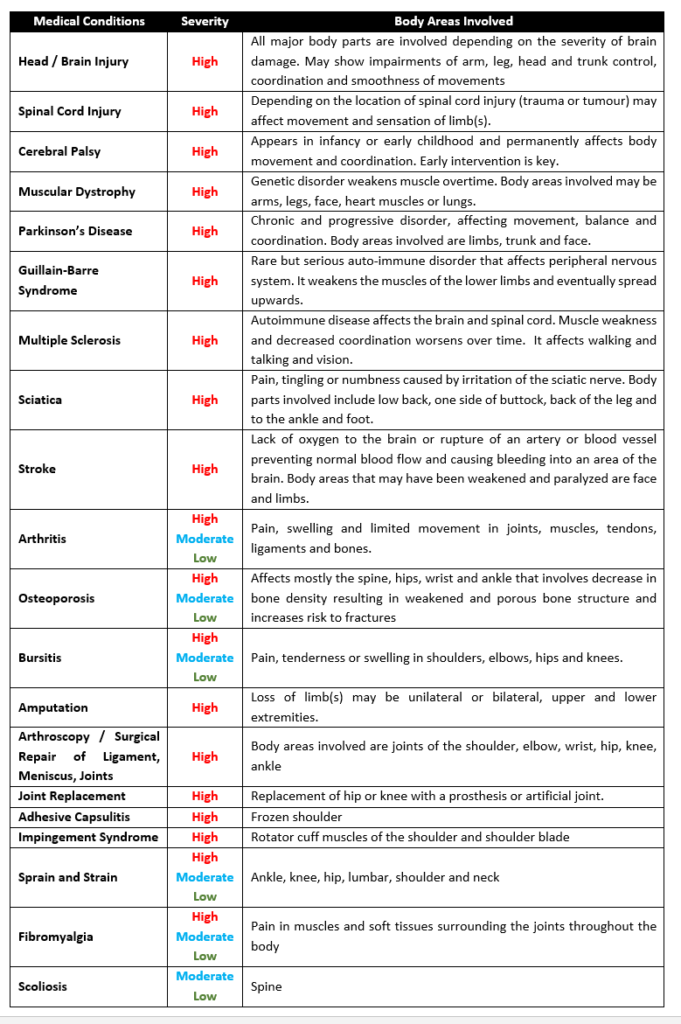
The MINI CLINIC ™ therapy treatment concept is supported by the following medical sciences and rules.
Wolf’s Law
As loading increases, overtime the bone remodels itself to become stronger.
Overload Principle
Greater than normal stress or load on body is required for adaptation to take place.
SAID Principle
Adaptation to Imposed Demand (SAID) means that the body is always trying to get better at exactly what you practice.
Reversibility Principle
Related to the biological principle of Use and Disuse.
Standing Therapy
Rehabilitation solution based on medical principles and laws of science.
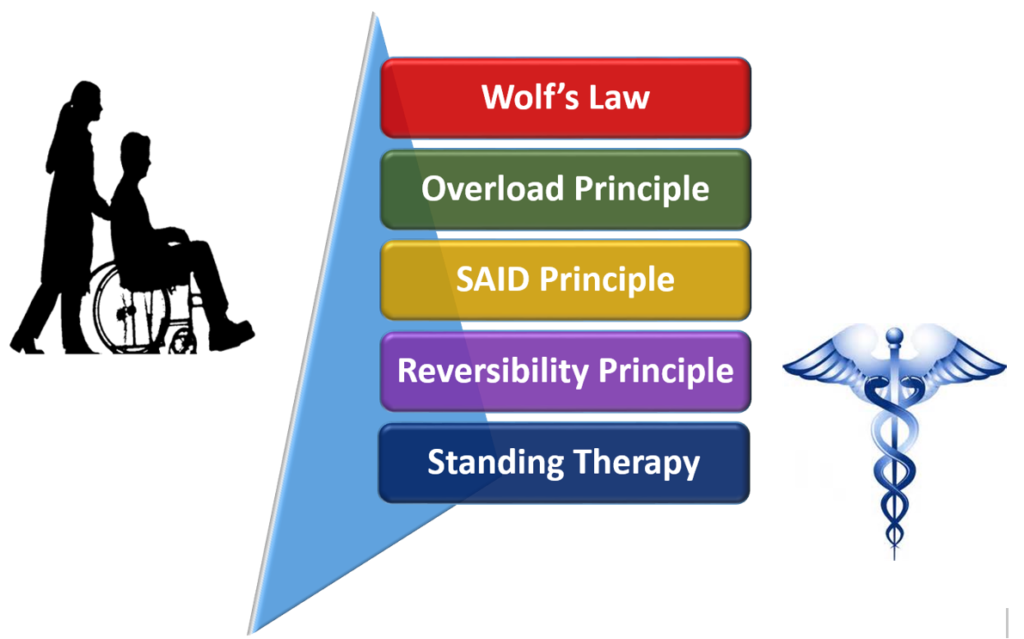
The clinician prepares the MINI CLINIC ™ for patient use with the following activities.
- Unpack LL CORPUS: MINI CLINIC ™ Frame Packing Box and take out Body Harness and Padded Buttock wrap.
- Take Body Harness from Storage Bag and place on lap.
- Unfold Body Harness to display front side (located on both side of Body Harness).
Set-up Camera (on Tablet) on Holding Bracket. - Position wheelchair/chair inside the LL CORPUS: MINI CLINIC ™ on Feet Guide Mat (with marking for wheelchair / chair positioning)
- Use Hold-on Bar for body support during exercise sessions.
- Press Remote Control (Down Button) to lower Hanger Assembly.
- Attach Body Harness Shoulder Straps to the left and right hook of the wide- curved Hanger Assembly.
- Insert Loop located in Body Harness adjustable shoulder Straps hooks onto the wide curved Hanger Assembly.
- Fasten (2) Body Harness Velcro Abdominal Straps to two (2) buckles and pull each strap to tighten around waist.
- Press Remote Control (Up Button) to lift body to standing position.
- Position feet onto Feet Guide Mat foot patterns when body is erect and in standing position.
- Grasp Hold-on Bar for additional body support.
- Initiate approved physical therapy exercise regimen, with Hold-on Bar support. The following exercises will be enabled by LL CORPUS: MINI CLINIC ™.
- Hip flexion, Hip abduction, Heel raise, Marching, Hip extension, Weight shifting
- Attach Rehab Accessory to LL CORPUS: MINI CLINIC ™ as prescribed by clinician.
- Press Remote Control “down” Button to lower body to wheelchair / chair.
- Unbuckle two (2) Body Harness Abdominal Straps to release Body Harness from body.
- Pull away Body Harness shoulder Straps from wide-curved Hanger o release Body Harness Shoulder Straps.
- Unbuckle Body Harness Shoulder Straps from the Hanger Assembly.
- Complete body removal from Body Harness.
- Press Remote Control Up Button to return Hanger Assembly to the Housing Component.
- Store Body Harness in Body Harness Storage Bag.
It is recommended that a licensed physical therapist develop a personalized therapeutic exercise program based on the patient’s medical condition as reflected in a physician’s prescription.
The MINI CLINIC ™ is aimed for use by rehab candidates that can participate in therapeutic activities and exercises. The equipment is not designed for lifting passive, dependent or obese patients. Prior to use, all patients need to be deemed medically stable and appropriate by a licensed healthcare professional.
Patients with the following diagnoses, symptoms or findings should not use the MINI CLINIC ™:
- Unstable fractures
- Halo neck support
- Uncontrolled hypertension
- Orthostatic hypotension
- Uncontrolled diabetes
- Severe osteoporosis
- Mental illness (with combative, abusive, agitated, irritable, aggressive behavior)
- Dementia with complete confuse mental status
- Passive or lethargic condition
MINI CLINIC ™ safely mechanically lifts and lowers the patient from a sitting position to standing thereby, eliminating the physical handling of patient by multiple therapists or caregivers during therapeutic exercises in a safe and secure environment. The patient is always secure in a LL Corpus designed harness enabling various levels of static and dynamic balance exercises without fear of falling.
MINI CLINIC ™ incorporates a remote-control operated motorized patient lifting system that accommodates the vertical displacement of the center of gravity that occurs during normal Gait. When walking, an individual’s center of gravity typically moves through a vertical range from one to four inches, depending on walking speed.
MINI CLINIC ™ features an unweighting system and partial weight bearing exercises for patients to re-learn walking. Body weight support is a method customized to patient’s level of readiness to engage in therapeutic exercises by allowing reduced weight and pressure to load onto the muscles and joints.
MINI CLINIC ™ enables comfortable loading for patient to tolerate activities in toe-touch weight bearing (TTWB), partial weight-bearing (PWB) and weight bearing as tolerated WBAT), ultimately to full weight bearing (FWB). The body harness wraps around the abdominal area and thighs to provide a secure fit when offloading a patient during unweighting activities.
Patients lacking upper body strength and or unable to support their own body weight is now able to safely transition to upright standing position essential in evaluating posture, balance, coordination and gait.
Within prescribed exercises the equipment enables patients to stand erect, move body one foot forward and one foot backward within available range, move body one-foot sideways left and right within available range. While on body harness, the patient’s vital signs and body response to activities or exercises are continuously monitored throughout the session via body movement and vital sign sensors.
The MINI CLINIC ™ supports patient post-operative rehabilitation protocols as shown in the below tables.
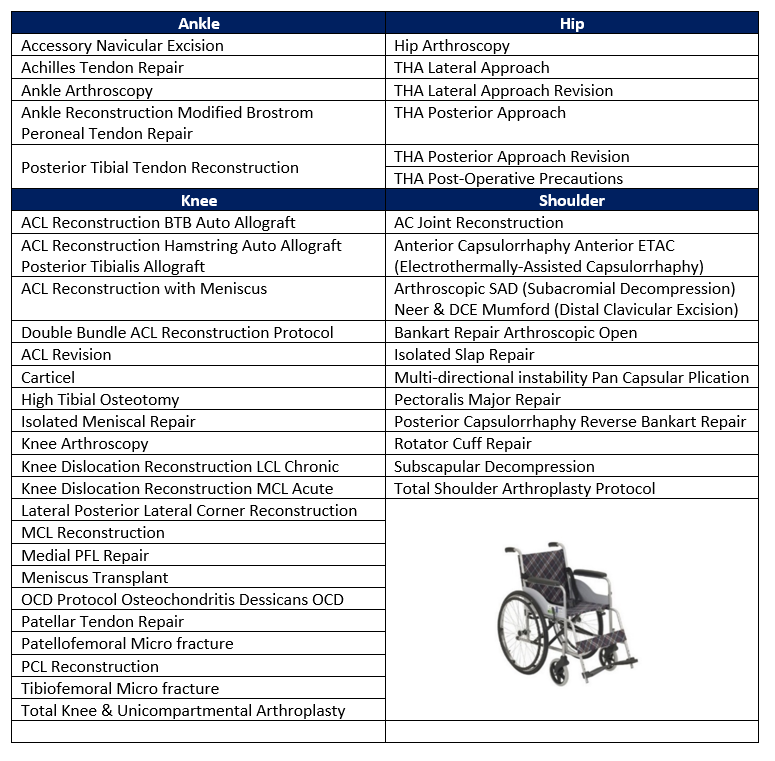
The LL Corpus: MINI CLINIC ™ Body Harness is an innovative solution that addresses traditional harness ‘pain points’ and enables patients to comfortably and safely conduct rehabilitation programs.
The Body Harness is designed:
- With a unique strap structure that comfortably and securely eliminates uplifting forces from body-weight support systems.
- Allows necessary movements to replicate natural ambulation without harness slippage.
The Body Harness helps patients:
- Reduce discomfort, with a soft, padded and unpadded straps and Velcro®, that provides comfort without limiting movement. This is of particular importance for patients moving from a seated to standing position.
- Decrease pressure to soft tissue or bony prominences resulting in blood flow circulation to lower extremity, upper extremity or chest area.
- Maintain position securely against the patient’s body, unlike conventional harnesses, the chest band is free from connection points attached to a hanger / body-weight support system which can lead to the harness ‘riding up’ into the axilla and causing discomfort.
- Safely place and wear Harness thereby eliminating emblematic discomfort and excessive time required for pre-exercise activities. Body impingement by conventional body harness straps into the patient’s groin and axilla make it difficult for clinicians to embolden patient confidence and intensity during rehabilitation.
- Perform therapeutic exercises in various positions (prone, supine, sitting and standing) without requirement of tedious and multiple adjustments.
- Increase patient tolerance in therapy session due to light weight characteristic of Body Harness.
- Allow normal breathing, does not restrict movement of thoracic area and rib cage.

B. Value Proposition
The MINI CLINIC ™ patient benefits comprise:
- • Support integrated physical and occupational therapy with one device: Gait, Balance, Transfers, Cognitive and Activities of Daily Living (ADLs).
- Safe and secure rehab environment for patients, clinicians, healthcare professionals, and caregivers.
- Increase clinician face time resulting in improved positive and quicker recovery.
- Achieve controlled reduction of weight bearing.
- Safely lifts patient to standing position with assistive supported suspension. (450 lbs.)
- Eliminate need for two or more people to assist in lifting and holding patient.
- Commence gait training earlier in the rehab recovery, and at lower level.
- Adjust weight bearing load on the weaker side of body.
- Stand and exercise within proper upright body posture.
- Empower patient self-confidence: vital in reaching rehab goals.
The MINI CLINIC ™ provides clinician benefits that encompass:
- Support integrated physical and occupational therapy with one device: Gait, Balance, Transfers, Cognitive, and Activities of Daily Living (ADLs).
- Work within safe and secure rehabilitation environment and safe equipment.
- Increase clinician productivity with increased patient face time.
- Provide multiple exercise types: unweighted, suspension, weight lifting.
- Chart patient progress on Cloud-based mobile digital device.
- Collect and observes patient vital signs and body movements via sensors throughout sessions.
- Video records and monitors patient rehabilitation sessions remotely.
The MINI CLINIC ™ provides clinicians the ability to conduct patient therapy programs within one device supporting:
- Weight bearing and posture to correct asymmetric movement.
Gait patterns. - Symmetry and weight shifting.
- Coordination without balance fears.
- Hip alignment.
- Range of Motion (ROM).
- Sit to stand, balance, and posture.
- Standing from chair or mat.
- ADL exercises.
- Cognitive exercises.
Key healthcare facilities benefits for use of MINI CLINIC ™ with patients rehabilitation and wellness programs comprise:
- Support integrated physical and occupational therapy with one device: Gait, Balance, Transfers, Cognitive and Activities of Daily Living (ADLs).
- Improve clinician productivity and patient face time.
- Increase number of patients handled and receiving therapy by individual clinicians.
- Reduce equipment capital cost and support expense.
- Decrease liability insurance.
- Provide safe and secure environment supporting one clinician to treat problematic patients.
- Lessen risk of injury to clinician and healthcare profession staff, and risk of falls to patients.
- Provide treatment to patients previously not suitable for physical therapy due to severity or complexity of condition or cognitive levels.
- Comply with OSHA “35 Pound Rule” for lifting and transferring objects or humans.
- Create enjoyable therapy and motivating environment for patient and clinician.
- Generate additional revenue opportunities: add occupational therapy and wellness services and, use MINI CLINIC as a sales asset in promotions to potential patients, family members, and caregivers.
C. Rehab and Wellness Approaches
The MINI CLINIC ™ provides capabilities that support patient rehabilitation including:
- Unweighted
- Suspension
- Weight-Lifting
- Eye-Hand Coordination
The MINI CLINIC ™ was designed as unweighting equipment offering support for orthopedic injury and musculoskeletal conditions, by allowing patients to train for longer periods with repetitive movement within their pain-free range of motion. Treating abnormal gait or body movement impairments require a great deal of repetition to normalize movement (of arm, whole leg, or foot, hip, etc.)
Patients recovering from neurological conditions, with use of MINI CLINIC-supported unweighted training, may move beyond the limitations of their pathologies to experience more rapid movement in a corrected gait pattern with significant functional carryover to their unaided over the ground gait. Posture, balance and coordination are essential components within Gait rehabilitation.
Posture assessment is a key element in patient initial evaluation It is defined as the position or bearing of the body. Hence, a patient’s ability to relearn walking depends on posture, the core strength, trunk alignment, mechanical abilities and tensional relationships throughout the body.
Along with posture, physical therapists also evaluate and treat the patient’s balance. The term balance in physical therapy is defined as the ability to keep your center of gravity (COG) over your base of support or over the central mass of your body.
Balance impairments may come from many medical conditions like brain or spinal cord injuries, inner ear problems, any dysfunction or impairment of the peripheral nerve or musculoskeletal system.
The primary benefits of unweighing occur in a variety of physiological ways as outlined below.
- Symmetrical Loading of the Lower Extremities
This assists with equal weight distribution over the base of support. Equal weight distribution in turn provides the proper biomechanics to correct step length deficits and time distribution between limbs.
- Reduction of Muscular Splinting
Parasympathetic tones typically associated with neurological pathologies can be reduced through PWB therapy. Minimizing parasympathetic stimuli help to reduce muscular tension allowing for increased range of motion (ROM) and focus on motor control exercises.
- Reduction of Cardiovascular and Metabolic Demands
Relieving portions of body weight allow the patient to exercise with less stress to the cardiopulmonary system, beneficial for deconditioned patients as it allows them to initiate exercise without increasing cardiopulmonary demand. VO2 levels are maintained better at 40% unweighing than at 0%, the patient can then also exercise for a longer period. This application can be beneficial for cardiac and pulmonary rehabilitation.
The value to patients using the MINI CLINIC ™ unweighing capability encompasses:
Acute Injury and Post-Surgical
Unweighing provides a safe environment to start acute therapy following injury or surgical procedures. For example, a patient with total knee replacement, the physician may require partial weight bearing in the early phase of gait training. Unweighing provides an environment around the knee joint with reduced gravitational effects; this can be coupled with strengthening and stabilization exercises to muscle groups surrounding the knee to enhance joint stability.
Vertical traction is accomplished to provide patient relief. This same approach can be taken with other orthopedic injuries.
By using the MINI CLINIC ™, you can be assured that your patient is working in a dynamic environment consistent with physician specifications.
Since the weight of the patient is supported, there is increased safety for them and the clinician, should a fall occur.
Balance Training
The MINI CLINIC ™ provides a safe environment during balance training. Securing the patient in an unweighing approach eliminates the risk for falling.
The somatosensory input provided by the Body Harness promotes proprioceptive feedback as to to location of the trunk over the base of support and will allow the patient to work with more confidence during rehabilitation. Further, the body harness provides freedom of movement. It enables patient to respond to repetitive stimulation of balance faculty to facilitate neuro-muscular pathway for normalization of movement patterns.
Oscillation of Center of Gravity (COG)
Normal oscillation for the center of gravity during gait is approximately 2″ (5cm). This is easily achieved with the dynamic suspension of the MINI CLINIC by allowing oscillation, hence, the patient can maintain a smooth gait pattern.
When a static support system is used, the center of gravity is raised, the system is not able to maintain a constant unweighing. During toe, off, the patient may be full weight bearing, which may cause undesired firing patterns of the musculature, resulting in poor training effects.
Knee Flexion Through-out Gait Cycle
To provide for shock absorption and mechanical efficiency, the knee must flex at various points during the gait cycle.
The knee is observed for proper flexion, extension and general stability in the various phases of the gait cycle. Knee flexion also allows ground reaction forces (GRF) to occur. GRFs are important for motor firing patterns associated with motor pattern and central pattern generators.
The dynamic environment of the MINI CLINIC unweighing capability allows for development and utilization of these GRF in the re-training of gait.
Single Point Design
A single point of suspension allows proper shifts of the COG and proper pelvic rotation during gait.
By providing natural shifts of the COG strengthening and coordination can be rehabilitated to their original state. Unweighing Systems that provide a two-point support design do not allow for the necessary shift of the COG over vital points necessary for gait.
The two-point design suspends the patient in a static “hanging” position, not allowing lateral pelvic tilts and pelvic rotation necessary for efficient gait mechanics. Lateral pelvic tilt of approximately 1″ allows the body weight to be centered over the hip, this allows the non-weight bearing leg to swing through.
The pelvis then rotates forward with the weight bearing hip acting as a fulcrum allowing forward movement of the non-weight bearing limb. The single point design of LL CORPUS: MINI CLINIC ™ unweighing capability allows for proper biomechanics of the pelvis and utilization of trunk musculature for stabilization and forward propulsion.
Fear of falls and other injury, the MINI CLINIC supports the patient’s need to regain self-confidence by way of eliminating risk of falling and eliminating restrictions born out of multiple persons handling the patient to sustain a safe standing upright posture.
The clinician can conduct hands on, musculoskeletal or neurological facilitation techniques. The goal of the physical therapist when assisting patients with MINI CLINIC is to bring them to a structural balance while in the Body Harness with freedom to move upper and lower extremities and trunk. The MINI CLINIC achieves the necessary safe positioning of the body in an upright, erect, standing and weight bearing posture.
The MINI CLINIC ™ allows the clinician to work on the patient’s coordination in standing position. While safe in the Body Harness and maintaining upright position, the patient can receive hands on, sensory motor techniques from the therapist to enhance equilibrium.
It is important that all three components – posture, balance and coordination – make an integral whole in Gait recovery. To maintain posture and balance, patient needs to relearn control of upper and lower extremities as well as trunk and head. For example, a patient who can keep a sitting or standing upright posture will need to balance to reach forward without falling and in reaching he needs to coordinate movements of the reaching arm with the bending of legs, trunk and leaning of head forward to complete the task.
All the body’s activities cause a shift in center of gravity or body weight. The patient’s recovery in ambulation needs to be based not only on her/his ability to stand erect and posture right, but also perform a smooth, controlled and fluid coordination of arms, legs, trunk and head.
There are many neurological and musculoskeletal disorders that affect body movement, balance, coordination and sensation. Most common orthopedic disorders vary with age. For instance, in children and teenagers, growing pains, broken bones, sports injuries and overuse injuries are common. Among adults, most common are arthritis, bursitis, tendonitis, fibromyalgia, plantar fasciitis, total joint replacement, impingement syndromes, low back pain, osteoporosis and amputation. Any dysfunction or impairment of the central nervous system, spinal cord, peripheral nerve or musculoskeletal system can result in an abnormal gait.
The concept of suspension therapy may be applied to full body or partial/body part to specifically target muscles. For example, a patient with movement restrictions due to shoulder joint tightness benefits from suspension method of treatment.
The upper extremity is suspended by the Red Cord component as a sling to eliminate pressure or unweighted while exercising the arm to focus on increasing joint range of motion without pain.
Suspension training enables strengthening deconditioned or weak muscles by using patient’s body weight. Training with body weight in slings as in ‘suspension therapy’ improves muscle strength, endurance, balance, coordination and core stability.
The rehab accessories or attachments provided by MINI CLINIC promote weight-lifting capability. Training with weights benefits the physical, health and mental aspects of individuals. One of the best ways to control bone loss is to add strength training into the regimen. Use of a Theraband or free weights available in MINI CLINIC improves bone density as explained in the medical principles and laws of science.
Weight lifting is strength training as it increases the strength of the connective tissue, muscles and tendons. This leads to improved motor performance and decreased risk for injuries. Weight-lifting capability provided by MINI CLINIC ™ not only promotes muscle strength, it also improves quality of life. Patient develops self-confidence with ability to perform activities of daily living (ADLs) or tolerating harder and longer physical work.
Weak eye-hand coordination can greatly compromise your ability to exercise and perform basic ADLs as writing or feeding self. Eye-hand coordination allows the eyes to indirectly coordinate the movements of the hands. Eyes send electrical signals to the brain providing information about visual stimuli. The brain then sends signals to the hands telling them how to move in response to these stimuli. Both gross motor skills and fine motor skills depend on eye-hand coordination. The MINI CLINIC OT Board and supporting accessories offer innovative therapeutic exercises to stimulate, develop and improve visual-motor integration skills focusing on outcomes like ability to tie shoes, button and zip, use eating utensils, open a jar, turn a door knob and much more.
The MINI CLINIC ™, with OT Table and supporting accessories, support various therapeutic exercises as building blocks to learn movement patterns which in turn results in functional patterns necessary in achieving ADL goals.
The unique rehabilitation solution of the MINI CLINIC ™ is its design focusing on treating gait abnormalities, balance impairments and muscle weakness and other neurological and orthopedic dysfunction, it also brings significant purpose to wheelchair bound or home bound individuals. MINI CLINIC provides solutions to manage circulation problems, enable pressure relief, prevent joint contractures and promote bone health.
There are many individuals who may benefit from the Standing Therapy, as, fear of falling and lack of support leaves them sitting in wheelchair for the most part of the day. Similarly, home bound patients or residents in assisted living facilities who may present potential in restoring balance, strength, and independence may experience limits in pursuing functional or personal goals. MINI CLINIC ™ allows for customized exercises and level of challenge to promote health and fitness while ensuring total safety.
MINI CLINIC ™ offers upper body and lower body conditioning exercises, with or without weights, may be done in sitting or standing position, may use suspension or unweighted method, focus on core strengthening and weight training. MINI CLINIC ™ is utilized for wellness, the associated positive outcomes and benefits are illness prevention, increase productivity, decrease hospital admission and re-admission, and improve longevity.
MINI CLINIC ™ design supports three valuable healthcare recognized physical rehabilitation treatment approaches:
Standing Therapy
Standing therapy improves motor function for individuals who lack the strength to stand and keeps them in a good position to stretch their lower extremity and trunk muscles for extended periods. This stretch can help to maintain and improve lower extremity range of motion. Standing has a positive effect on spasticity. Decreasing spasticity assists in maintaining and improving range of motion and improving overall level of function. Standing has been shown to improve circulatory, gastrointestinal, bowel control, and respiratory functions.
Partial Weight Bearing (PWB)
Unweighting system to reduce weight and pressure for comfortable loading onto the muscles and joints.
Body Weight-Support (BWS)
Body Weight Support (BWS) training is an intervention used to provide an environment that facilitates re-learning of gait following a neurological injury.
Neuro-Plasticity Approach
Ability for the nervous system to reorganize, re-wire, transform, and renew itself. Neuroplasticity is how we adapt to changing conditions, learn new facts, and develop new skills. If the brain is injured, it tries to repair itself with these normal mechanisms. The old model assumed that a person was born with a finite number of brain cells, and when a cell died, no new cell grew in its place. This old model is no longer relevant because it has been proven that certain areas within the brain can generate new cells as well as create new neural pathways.
Standing Therapy is a protocol that supports patient programs involving weight bearing, loading, and pressure. Patients with joint instability and remarkable muscle weakness perform standing therapy by utilizing MINI CLINIC ™ Knee Support and Hold-on Bar.
Use of Standing Therapy during acute rehab helps accomplish goals by combining the proven benefits of a standard standing program with those of a reciprocating movement.
Standing Therapy supports individuals with spinal cord injury (SCI), neurological injury, cerebral palsy, wheelchair users. Patients can experience the following key benefits:
- Eye-level interaction: Standing devices provide the opportunity to stand and interact with peers and family at eye level. This equipment allows the patient to participate in mild or vigorous activity while enjoying the emotional benefits of being in an upright standing position.
- Trunk Control: By modifying the amount and location of support, physical therapists can challenge the patient’s trunk control and balance. This carries across a patient’s therapeutic goals to improve mat mobility, activities of daily living, wheelchair management and transfer skills.
- Contracture Management and Cardiovascular Training: A gliding program helps prevent contractures at the hips, knees and ankles, secondary to weight bearing and mobility. Standing with a glider frame offers the patient a unique opportunity to control lower extremity movement through assistance from the upper extremities. Because the patient controls the assistance of the upper extremities, he/she also controls the progression of cardiovascular training.
MINI CLINIC supports use of Healthcare Industry recognized GAIT Analysis in patient evaluation and treatment.
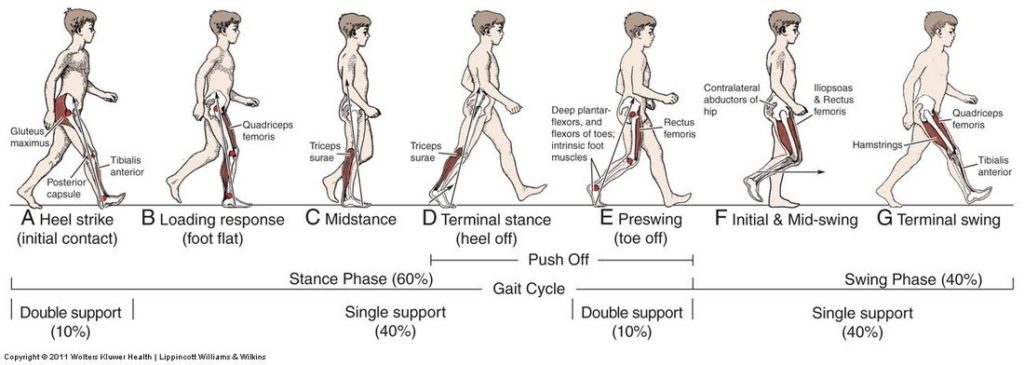
Patients with neurological or musculoskeletal disorders have different levels of tolerance or medical requirements when engaged in Gait training. The ability to initiate exercise early in the rehabilitation process, with MINI CLINIC ™ can benefit the patient by allowing development of neural pathways through muscular patterning.
Typically used with neurological pathologies, the patient’s body weight is supported between 20%-40% to assist with developing proper gait patterns and improvements in cardiovascular and muscular endurance with less physical demand.
The MINI CLINIC ™is designed to be used in two ways:
- MINI CLINIC ™ may function primarily as a stand-alone structure supporting therapeutic exercises without use of physical therapy attachment or exercise tools.
- MINI CLINIC ™ supports use of ‘best-in-class’ rehabilitation equipment with customized exercises included within LL Corpus Patient Exercise Guide.
The following equipment aligns with customized exercises included within LL Corpus Patient Exercise Guide.
- Red Cord
- TheraBand
- Swiss Ball
- Treadmill
The clinician will prepare a customized physical therapy program for the patient based on the patient’s medical condition and physician’s prescription. The program will include one or more of the exercises and timing for each exercise and the total session and frequency.
The MINI CLINIC ™base exercises performed by patients without accessories are outlined below.
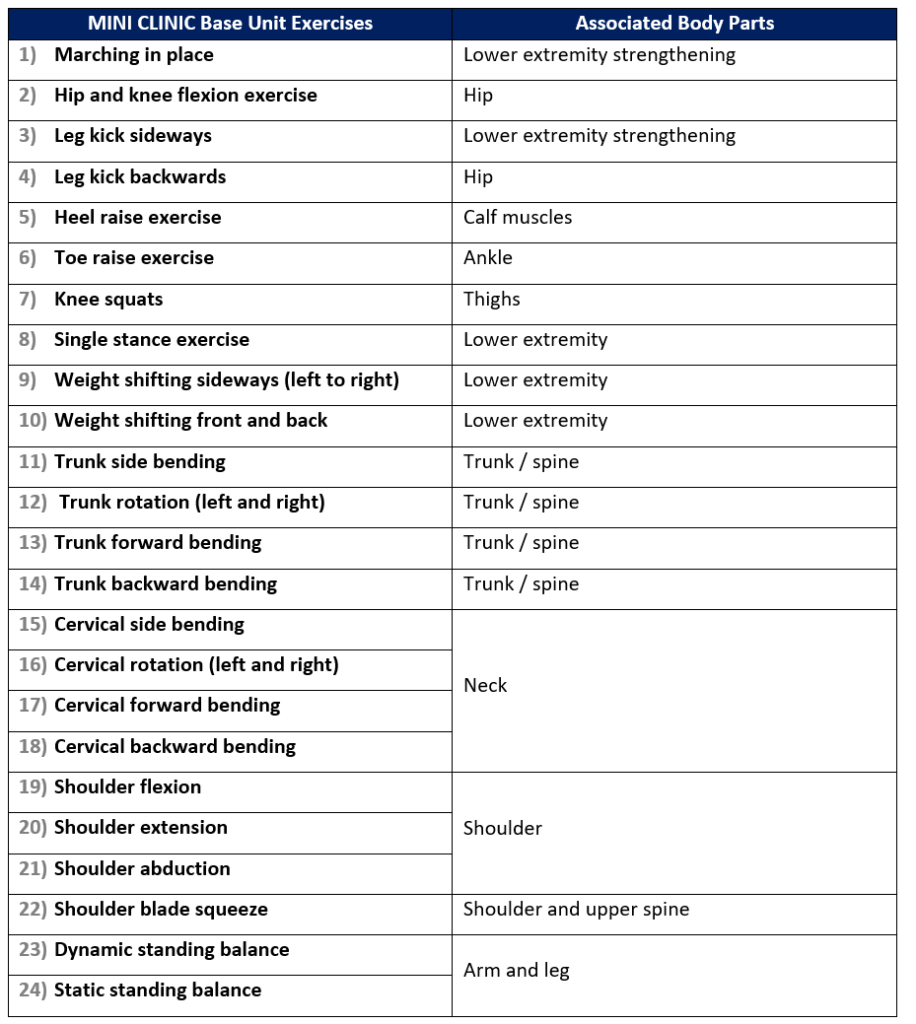
MINI CLINIC ™ supports Red Cord equipment use with patients. Customized hooks have been developed to attach the Red Cord to MINI CLINIC ™ structure. Red Cord developed and recommended physical rehabilitation exercises are described within the MINI CLINIC ™ Exercise Manual.

The following Red Cord exercises are customized for use by patients.
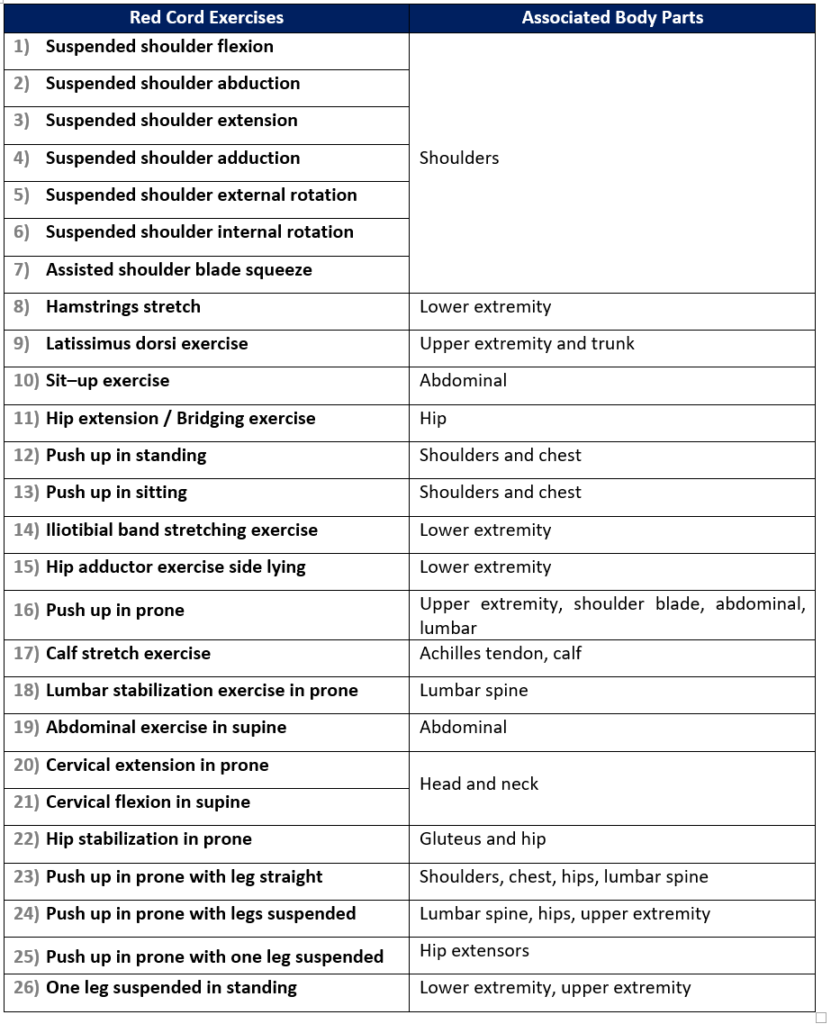
MINI CLINIC ™ supports TheraBand equipment. Customized hooks have been developed to attach the TheraBand to MINI CLINIC structure. TheraBand developed and recommended physical rehabilitation exercises are described within the MINI CLINIC Exercise Manual.

The following Theraband exercises are customized for use by patients.
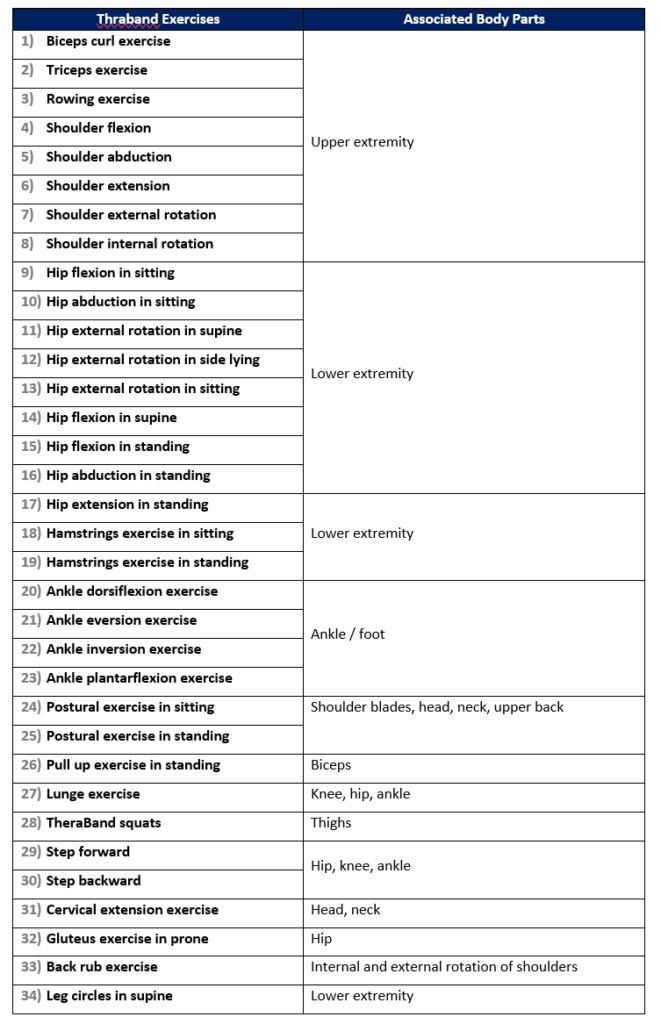
MINI CLINIC ™ supports use of Swiss Ball equipment. The following Swiss Ball exercises are customized for use by patients.
- Abdominal Draw In, Seated on Swiss Ball.
- Abdominal Draw In, Seated on Swiss Ball, add Marching
- Abdominal Crunches on Exercise Ball.
- Abdominal Crunches on Exercise Ball with rotation.
- Abdominal Draw In, Seated on Exercise Ball l with leg extension.

MINI CLINIC ™ supports use of Treadmill equipment. The following Treadmill exercises are customized for use by patients.
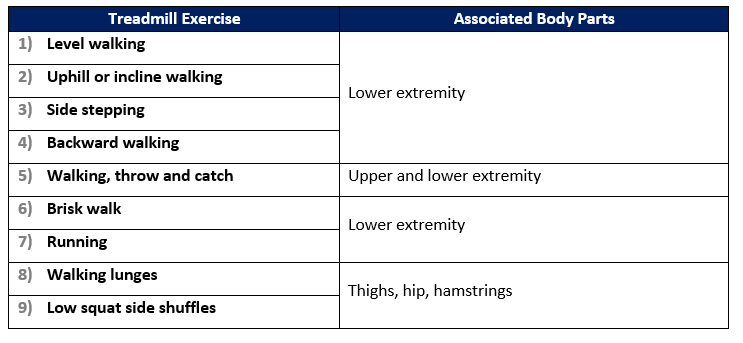
D. Physical Difficulties & Functional Goals
The MINI CLINIC ™ is intended for use by physically disabled (temporary and permanent) people primarily with difficulty in:
- Walking
- Balance
- Coordination
- Muscle Weakness
The MINI CLINIC ™ assist patients achieve functional goals, namely:
- Improve Strength
- Mobility
- Independence
The MINI CLINIC ™ is also a wellness product that enables home bound or wheelchair-bound individuals to improve their quality of life and adherence to prevention (e.g. circulation problems, edema, contractures, pressure sores, and decubitus ulcers).
The MINI CLINIC ™ enables clinicians to thoroughly evaluate and treat Gait problems and other physical impairments earlier in the rehabilitation process with greater safety, less restrictive harnessing, and less need for multiple therapists and / or caregiver assistance. clinicians can use the MINI CLINIC on patients with neurological or musculoskeletal deficits utilizing wide range of therapeutic exercises and rehab approaches.
The MINI CLINIC ™is designed for use in hospital settings outpatient rehabilitation clinics, senior care facilities and patient homes.
E. Digital Supporting Technology
MINI CLINIC obtains patient vital signs, with sensors, and manages within the Patient – PT Assist Software App.
- Heart Rate (Pulse)
- Respiratory Rate.
- Blood Pressure.
- Body Temperature.
- Pain
MINI CLINIC ™ obtains specific body movements, via sensors, and manages within the Patient – PT Assist Software App.
- Sensitive measures of impairment and therapeutic outcomes.
- Detect Body Motion: Indicator of predictable patient response, motion and movement (that may not be visible by the human eye).
- Observe Body Functional Use: Indicator of functional recovery with overlays of initial and subsequent body movement sessions.
- Identification of definite impairments to better target therapy.
- Provision of precise, objective measures.
- Automatic, longitudinal tracking of patient progress.
- Biofeedback response to support proper practice and improve motor learning.
MINI CLINIC provides patients’ the capability to be immersed and interact in a live 360 degree ‘Virtual Reality (VR) view of a physical real-world environment game scenario augmented by computer-generated sensory input of sound, video, graphics or GPS data. Patients are provided VR Glasses (see illustration below) that are used while engaged in the VR session.
The key goals include:
- Increase caregiver efficiency
- Reduce patient suffering and pain
- Improve recovery outcomes
- Decrease level of care or assistance from caregivers.
The motivational characteristics of VR computer-aided games can stimulate the continuous exercise, correcting patient movements and distracting pain.
VR can be programmed to divert pain distraction attention of physical rehabilitation patients away from the pain involved with their treatments. For example, amputees can use virtual environments to manage phantom limb pain.
F. Warranty & Support
LL Corpus provides purchasers of MINI CLINIC ™ the following product Warranties.
Limited Product Warranty (LPW): LL Corpus Cogere, Inc. warrants that the MINI CLINIC ™ will be free from defects in material and workmanship under normal use, service, proper set-up, and proper operation. The warranty is for a period of one year on the parts from the date of the original product purchaser from LL Corpus or an authorized LL Corpus retailer. The Warranty is providing at no-cost to the original purchaser of the LL Corpus product.
THIS WARRANTY SHALL NOT APPLY TO A MINI CLINIC ™ WHICH HAS BEEN SUBJECT TO ABUSE, MISUSE, ALTERATION OF ANY TYPE OR CAUSE OR TO ANY DEFECT OR DAMAGE CAUSED BY IMPROPER SET-UP, REPAIR, REPLACEMENT, SUBSTITUTION OR USE WITH PARTS OTHER THAN PARTS PROVIDED BY LL CORPUS.
Extended Product Warranty (EPW): Provides product coverage beyond the terms and the life of the LL Corpus Limited Warranty and provides updates to the same model purchased. The pricing of the service is 10% of the purchase price annually. The ESP allows for the full predictability of products service and maintenance cost.
The EPW provides around-the-clock access to knowledgeable LL Corpus customer technical representatives who provide reliable product support. With assistance, available both online and over the phone, the EPW helps customer’ discover ways to obtain the most value out of their purchase. The EPW assist with a wide range of product issues, including product set up, and troubleshooting.
A comparison of the LL Corpus MINI CLINIC ™ Limited and Extended Warranties is presented in the below table.

LL Corpus provides two MINI CLINIC ™ Set-up Guides to successfully unpack and assemble for patient use:
- Frame Set-up Guide 1
- Mechanical & Electrical Set-up Guide 2
The Set-up Guides are available to MINI CLINIC ™ customers at the LL Corpus Customer Portal for viewing and downloading.

